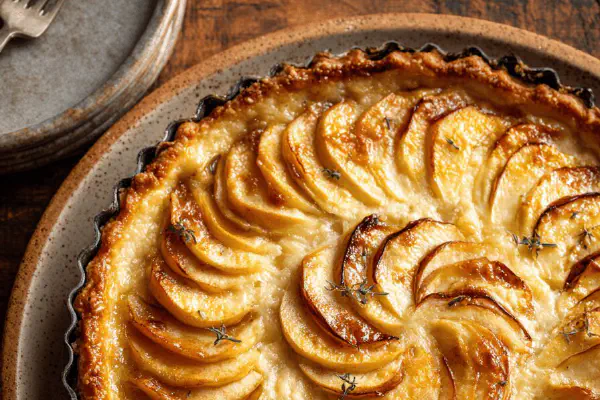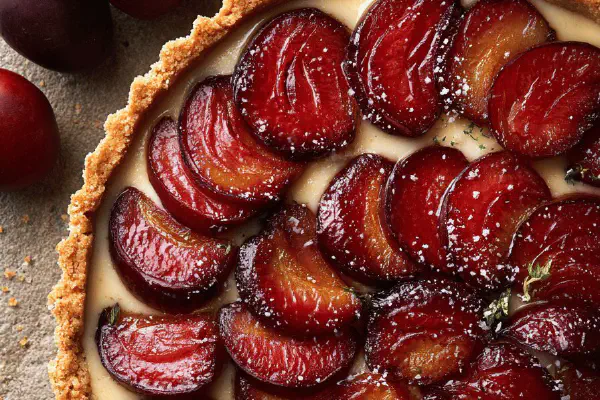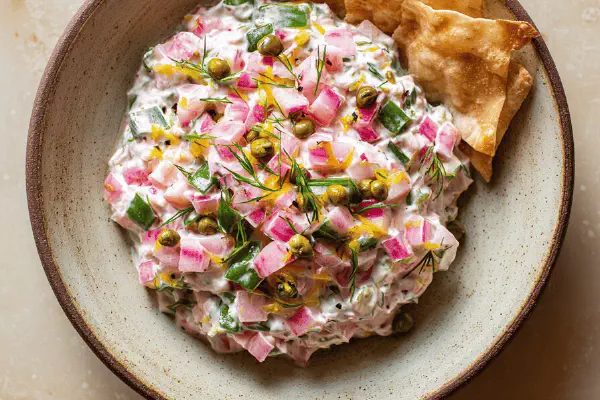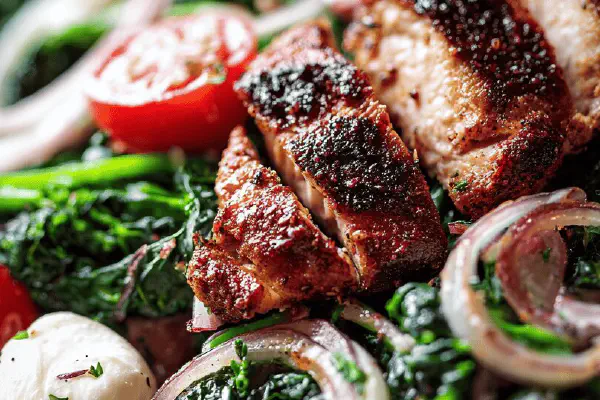Apple Marmalade Tart

E
By Emma
Certified Culinary Professional
•
Recipe tested & approved
Break flour, sugar, salt. Cold butter chunks, pulse fast. Water, just enough, to gather dough. Chill two discs. Roll thin, line 23cm pan. Slit second disc center, fridge 30 min. Mix brown sugar, a bit less flour. Swap marmalade for apricot jam, tangier twist. Dense Cortland and tart McIntosh, peeled slices, fold into jam mix. Layer filling, seal edges tight, fork marks tell it’s sealed. Brush with milk, bakes at 190C for 55 min — bubbly edges, golden crust crackle. Cool a bit, smell of baked fruit and caramel notes fills kitchen. Skip eggs, no nuts, straightforward technique but watch butter temp, no melting! Treat dough lightly, don’t overwork or tough crust.
Prep:
35 min
Cook:
55 min
Total:
Servings:
8 servings
#French inspired
#fruit tart
#pastry
#apple dessert
#apricot jam
#no eggs
#no nuts
Starts fast. Cut butter cold sharp. Mix flour rough not fine. Water barely. Dough feels soft but not sticky. Chill solid. Roll careful or splits. Apple mix combines tart and sweet. Jam swap keeps sweetness subtle, no bitter marmalade rind chunks. Crust thickens, edges crisp in heat. Watch bubbles rise like boiling sugar spots through vent flap. Smell holiday goodness. Crisp crust finally cracks under finger pressure. Sweet, fruity juices mingle with flaky crumb. I’ve learned: patience, respect butter temp, watch apple types. Every oven different; eyes must guide not timer.
Ingredients
PASTE BRISÉE
- 350 ml (1 1/2 cup minus 2 tbsp) unbleached all-purpose flour
- 15 ml (1 tbsp) sugar
- pinch salt
- 170 ml (11 tbsp) unsalted butter cold, cubed
- 100-125 ml (about 1/2 cup) ice water
FILLING
- 50 ml (3 tbsp plus 1 tsp) brown sugar packed
- 25 ml (1 3/4 tbsp) all-purpose flour
- 180 ml (3/4 cup) apricot jam instead of marmalade
- 700 ml (2 3/4 cups) Cortland apples peeled, thin sliced
- 700 ml (2 3/4 cups) McIntosh apples peeled, thin sliced
- milk for brushing
About the ingredients
Flour quality matters — unbleached creates better texture. Butter super cold, diced small. If butter melts or softens, chill dough longer. Water ice-cold, adding too much makes stiff dough, adding too little leaves dry bits. Jam choice alters final tart sweetness. Apricot jam mellows sharp apple flavor better here. Avoid watery apples. Cortland and McIntosh balance tartness with sweetness and soft cooking. Cassonade replaced by brown sugar fine grained — subtler caramel note. Milk for brushing, adds subtle crust shine and browning without eggs. No eggs here to keep it light and allergen-friendly. No nuts or eggs, simple pantry staples required.
Method
PASTE BRISÉE
- Start flour, sugar, salt in food processor. Pulse a couple short bursts. Add butter, quick pulses till pea-size chunks remain. Watch carefully; don’t over-mix or butter melts. Pour ice water gradually, pulse until dough barely holds. Press dough with hands to form two flat discs. Wrap, chill at least 30 minutes; crucial for flaky crust.
- Flour surface. Roll one disc thin (about 3 mm). Fit into 23 cm tart pan smooth down sides gently. Patch any cracks fast.
- Roll second disc, slice an ‘X’ or make a small hole in center — steam vent. Refrigerate 30 min minimum keeps shape.
- Preheat oven 190 Celsius. Middle rack for steady heat, minimizes burning bottom.
FILLING
- Stir brown sugar with flour. Add apricot jam, whisk until blended — changed from marmalade for subtler tartness, less pectin.
- Fold in apple slices coating evenly. Apples must be dry-ish, not dripping or soggy. If too wet, pat dry.
- Transfer filling into lined tart shell, spread evenly but don’t mound up too high; wet heat cooks unevenly.
- Brush rim edges with milk—helps seal. Place second dough on top, crimp edges firmly by finger or fork tines. Don’t skip sealing or juices leak everywhere.
- Brush top with milk. Optional: sprinkle fine sugar for crunch.
- Bake near bottom rack 55 minutes. Look for golden brown crust, bubbling filling peeking through vent. Crust shrinks from pan edge slightly.
- Remove tart, cool on rack. Cooling sets filling, easier slicing. Warm but not hot ideal for flavors to settle. Avoid soggy bottom by cooling fully if possible.
- Serve slightly warm or room temp. Cheese or cream side note: sharp cheese contrasts sweet fruit well if you like savory combos.
TIPS
- Butter must stay cold to layer into crumbs, not melt. Work fast, chill if needed.
- If dough cracks, patch with water and extra flour mix.
- Don’t skip flour in filling, thickens juices that otherwise soak crust soggy.
- If no food processor, use pastry cutter or two knives, minimal hands-on mixing.
- Apricot jam sub cut sugar as it’s less bitter than marmalade; adjust sweetness by eye on fruit ripeness.
- Watch oven color. Different ovens vary, rely on crust and bubbles not clock alone.
- Cooling fully avoids filling runny on plate.
- Use tart apple mix, avoids mush as softer apples break down too much.
- Seal edges tightly or filling will burst and ooze during bake.
Cooking tips
Food processor speeds mixing, but hand method okay. Butter chunks must stay visible for flakiness, check frequently. Dough pulsing tricky — stops just before full cohesion or risk toughness. Chill solid few minutes, never skip. Roll dough on lightly floured surface, patch cracks quickly with water to avoid dry breaks. Venting top crust essential for releasing steam, prevents soggy layers. Mixing apples with jam-flour blend prevents floating or squishing down in bright juice puddles. Crimp edges tight; leaks cause sticky mess and loss of filling. Brush milk not water, milk promotes golden finish. Bake on lower rack; mid rack browns top too fast. Watch crust color, bubbling tells internal heat readiness. Cool tart before cutting for firm filling. Once cooled, flavors meld, texture changes from fragile to sliceable. Don’t rush. Simple, but finesse needed or crust ends doughy or burnt.
Chef's notes
- 💡 Butter cold chunks key. Watch dough texture close. Pulse quick, stop before smooth. Butter melts wreck flakiness. Chill dough firm; skipping means tough crust or shrunk shape. Roll on floured surface. Patch cracks fast with water-flour mix. Roll second disc thinner but keep shape intact for vent. Venting vents, no soggy top layers.
- 💡 Apples moisture can drown crust. Slice thin, dry off excess juices. Fold into jam-flour mix that thickens and binds fruit. Apricot jam steadier than marmalade; less bitter, less pectin swelling. If jam watery, cut sugar or cook jam down beforehand. Filling consistency should not drip, keeps crust from soggy bottom.
- 💡 Seal edges tight, no leaks allowed. Use fork tines to crimp hard. Brush rim and top with milk, not water, brown sugar optional for crunch. Proper sealing prevents runny mess all over oven. Brush top just before baking to get golden sheen without soggy spots.
- 💡 Oven rack choice changes bake. Low or bottom rack for golden crust and bubbled filling. Middle rack risks browning too fast, leaving undercooked apple center. Baking time a guide only; watch for crust pulling away edges, bubbling vent, golden shimmer across top. Listen for soft crackles near end.
- 💡 Cooling crucial, don’t rush. Hot slicing breaks filling, mushy bottom common without full cool down. Flavors meld as tart settles. Cut warm or room temp. Sharp cheese on side works if savory contrast wanted. Keep dough and tools cold during prep. Melted butter means scrap and redo.
Common questions
How cold must butter be?
Cold as fridge stock. Cubed small but not melting. Warm butter blends bad, no crumbs form. Chill dough if soft. Cold butter chunks give flaky layers not greasy paste.
Can I swap apricot jam?
Yes, but marmalade harsher. Apricot smoother with less pectin so filling sets better. If marmalade used, reduce sugar a bit. Other fruit preserves possible but watch sweetness and moisture.
Why so much venting?
Steam needs escape or filling turns mushy under crust. Vent also signals bake done; look for bubbling juice. No vent risks soggy top layers and cracked crust from pressure.
How best store leftovers?
Room temp wrapped or fridge overnight. Cover loose or airtight container. Cold keeps filling firmer but chills crust slightly. Reheat gently to refresh crisp without drying.



